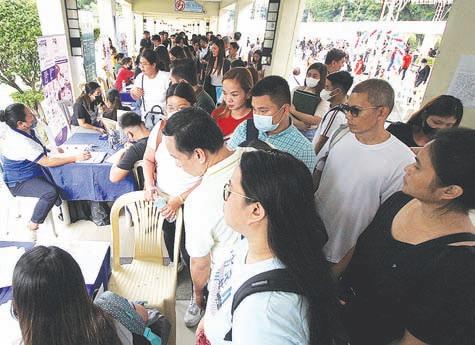
7 minute read
House panel asks DSWD to suspend 4Ps delisting of 1.3m families
By Maricel V. Cruz
THE House of Representatives committee on poverty alleviation has called on the Department of Social Welfare and Development (DSWD) to suspend its delisting or removal of up to 1.3 million poor families from the Pantawid Pamilyang Pilipino Program or 4Ps.
THE empowerment of women today, Sen. Cynthia A. Villar said, goes beyond protecting them from violence and other forms of abuse.
In her inspirational message during the National Summit of the Lady Local Legislators’ League (4L) of the Philippines, she noted that women’s empowerment “includes significantly providing them with opportunities to earn.”
“In our current times, women are deemed vital contributors to economic growth. It goes without saying that economically empowered women can augment their family’s income, put
1-Pacman Rep. Mikee Romero, committee chairman, said on Friday the committee voted last Wednesday to call for a delisting moratorium and for the DSWD to carefully assess the situation of families to be removed from the program and those who would replace them.
Romero said his panel supports the government’s effort to have more poor food on the table, and play pivotal roles in raising and educating their children,” she said.
“And these well-bred and educated children will then become the future assets of our nation,” Villar added. She told the participants in the event that she shares their advocacy for women’s empowerment.
The senator believes that “when we empower women, we also empower families, the society, and generations of people who will contribute toward nation-building.”
“In line with this, I would like to share that I have set up around 3,000 community-based livelihood projects and enterprises nationwide,” Villar said.
Filipino families benefit from the 4Ps program, which grants a monthly financial subsidy provided beneficiaries comply with a set of conditions, including ensuring that their children attend school.
“We are all for that, but let us make sure that the exiting families have really improved their financial status and some of their children have finished college and are now employed,” he said.
Romero said he and members of his committee are happy for covered families whose children have already earned their college degrees.
However, he said the DSWD should have realistic standards for removing beneficiary families from the 4Ps.
QC JOB FAIR.
Jobseekers line up for an interview during the first Overseas Job Fair at the Quezon City Hall grounds on Friday. The fair was conducted by the Quezon City Government through the Migrants Resource Center (MRC) of the Public Employment Service Office (PESO). Over 3,000 land-based and sea-based employment opportunities from various licensed recruitment agencies were offered.

Manny Palmero
By Melandrew T. Velasco
MANY people have thrown in their two cents worth on the flooding that occurred in the aftermath of Typhoons Egay and Falcon.
Flood-prone Bulacan and Pampanga were among the provinces badly inundated, both being catch basins of water from the Sierra Madre mountain range.
There are allegations the flooding, particularly in Bulacan, has been the result of the ongoing construction of the New Manila International Airport in the province.
The New Manila International Airport is one of the big-ticket infrastructure projects of the government started during the administration of President Rodrigo Duterte and it is now part of President Ferdinand Marcos Jr.’s BBM (Build, Build More).
It is envisioned as a world-class airport that will decongest the existing international airports in Metro Manila. Its project proponent is San Miguel Corporation (SMC).
Amid all the allegations dismissed by SMC, its President and Chief Executive Officer Ramon S. Ang (RSA) has offered to help solve the problem of flooding in the area. SMC is committed to assist the local government of Bulacan in solving the flooding problem in the province.
generations
It also plans to extend the desilting and clean-up of rivers outside Bulacan to include critical tributaries throughout Central Luzon.
Like earlier river clean-up by SMC, this extensive clean-up of rivers and waterways will be undertaken at no cost to the government.
RSA asserted there are many contributing factors to the flooding in Bulacan. “Degradation, siltation, and pollution of our rivers are of course major causes of flooding,” he said.
“Because of these, rivers become shallow and their flood carrying capacity is severely diminished, resulting in river overflow and floods. The proliferation of fish ponds in coastal areas has also contributed to severe flooding in the province,” he added.
SMC is an active partner of government in river rehabilitation.
With its heavy equipment and technical know-how, it has cleaned up the TullahanTinajeros River spending P1 billion without cost to government. The clean-up involved extraction of over 1.12 million metric tons of silt and solid wastes. This effort from SMC has greatly helped residents in nearby areas, giving them respite from flooding that used to occur every year when the rainy season sets in.
At present, SMC is undertaking the cleanup of Pasig River and has removed more
By Gustavo Gonzalez
TODAY is World Humanitarian Day.
It was on August 19, 2003, when the United Nations lost 22 colleagues in the tragic attack at the Hotel Canal in Baghdad, Iraq.
Since then, we commemorate WHD every year, paying tribute to the many humanitarian workers who have sacrificed their lives to bring relief to the millions and millions of people affected by crises.
As of August 9, a total 5,771 national humanitarian workers and 714 international staff across the globe have been either killed, wounded, or kidnapped while accomplishing their mission, as reflected by the Humanitarian Outcomes’ Aid Worker Security Database. Humanitarian work has become a highly risky responsibility.
We also acknowledge that the intensity, frequency, and overlapping nature of a new generation of crises—ironically captured by experts as “polycrisis”—is making humanitarian work still more complicated to the point of exhausting the capacities of an already overstretched humanitarian system.
While the demand for aid continues to grow, available funding falls tragically short.
The gap between humanitarian needs and funding allocations is striking.
Based on July 2023 report, requirements for the Global Humanitarian Overview have increased to $55.2 billion to assist 248 million of the 363 million people in need. However, contributions just reached 25 percent of the total funding.
From our field perspective, we are presently experiencing three major challenges, which are impacting our plans, work, and ambitions: First, climate change, which has a multiplier effect on pre-existing vulnerabilities.
than one million tons of silt and waste.
It is also desilting and extracting waste from the Meycauayan and Maycapiz/ Taliptip rivers as components of the plan to rehabilitate the Bulakan-ObandoMeycauayan-Marilao-Bocaue-Guiguinto river system.
Out of the initial 13-kilometer target along the Meycauayan and Maycapiz/Taliptip rivers, SMC has cleaned up about 4.45 kilometers with 543, 266 metric tons of silt and solid waste extracted.
The flood mitigation project of SMC in Bulacan at the onset was limited to rivers surrounding the site of the New Manila International Airport. It was however expanded to include other tributaries in Bulacan.
The flood mitigation project of SMC is reinforced by its mangrove planting initiative, part of the strategy to address flooding in Bulacan. Mangroves provide shield to those living along the coastal areas from flooding and provide natural habitat for marine species.
It was in 2020 when SMC began its mangrove planting initiative.
The initiative calls for the planting of 190,000 mangrove seedlings in 76 hectares in Bulacan and identified areas in Central Luzon. Its launch in Hagonoy, Bulacan saw the planting of 8,000 mangrove seedlings in an area of more than three hectares. A total of 25,000 mangrove seedlings were earmarked for planting in 10 hectares for 2020.
It has also collaborated with the Department of Environment and Natural Resources and planted 6,000 mangrove propagules a the 24.5-hectare Bulakan Mangrove Ecopark.
Aside from mangrove planting, SMC is also undertaking reforestation in many provinces. Its tree-planting activities are being carried out by its subsidiaries.
We are grateful for organizations like SMC. For over a century, it remains steadfast as a partner in the country’s sustainable development.
Its infrastructure projects are engines for economic development; and as it pursues these projects, it does not relinquish its responsibility to protect the environment.
I often wonder if heavy precipitation can be controlled.
I am not aware if there is already a solution to prevent this.
But we can find ways to minimize if not totally prevent flooding that comes with heavy rains.
As responsible citizens, we can do our share. We can help in the task of caring for our environment, including flood mitigation by managing our waste, properly disposing of our garbage and refraining from making our bodies of water as trash bins.
As our nation nears the celebration of National Heroes Day this month, I am reminded of our heroes who sacrificed and worked in the service and welfare of our nation and future generations.
Let us work for the betterment of our nation. Let us recall one of our heroes, Dr. Jose Rizal who said in one of his speeches
“if a Filipino wills, he can.” We can do it!


(The author is president and executive director of the Million Trees Foundation Inc., a non-profit group advocating tree planting and watershed protection. He is also a book author and publisher of biographical and historical coffee-table books through his outfit, Media Touchstone Ventures, Inc.)
And the Philippines knows very well about that.
The country lies within the typhoon belt and is part of the Pacific Ring of Fire exemplifying the intricate interplay between exposure to natural hazards, climate change impact, and humanitarian responses. More frequent and intense storms, such as the most recent super typhoon Odette in 2021, are exacerbating an already fragile situation and making the recovery process more arduous and expensive. These are compelling reminders that our conventional ways of relief must learn from experience and adapt if we want to effectively address the changing dynamic of climate emergency.
Second, the “unpredictability” of many emerging crises or—put into less diplomatic words—the uncontrolled nature of some crises that are escaping any measurement of their intensity, duration, and impact. The protracted crises in Syria and Yemen, as well as the emerging ones in Ukraine, Sudan, and now Niger, stand as self-evident examples of such disasters.
Third, the growing threats and risks that encircle humanitarian workers who are trying to save lives in the most challenging circumstances.
While these dedicated individuals and organizations strive to provide support and relief, they still find themselves navigating a hazardous landscape.
In this unprecedented context, the significance of humanitarian work becomes even greater and







